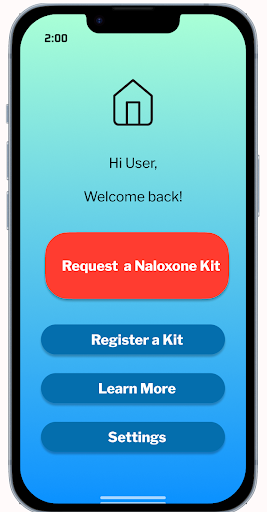NEED: Naloxone Emergency Evacuation Device
NEED: Naloxone Emergency Evacuation Device
Developed a mobile and hardware-based response system to reduce overdose deaths on campus. Designed a fast, privacy-compliant alert flow. A/B tested against PulsePoint AED, showing a 40% improvement in user response time under stress.

Overview
NEED is a mobile application and microcontroller-based device that connects overdose bystanders with nearby naloxone kits and responders in real time. Originally developed as a design competition project, it was later evolved through solo UX research, prototyping, and A/B testing to explore viability and scalability within university campuses.
- Role: UX Designer, UX Researcher (post-competition)
- Team: 4 members (initial design), solo research and testing
- Timeline: June 2024 – November 2024
- Tools: Figma, Miro, PulsePoint AED, Apple Research
- Focus: UX design for emergencies, usability testing, privacy-sensitive systems
Background
BC’s opioid crisis has had a measurable impact on post-secondary campuses, including the University of Victoria. Despite widespread distribution of naloxone kits, overdose-related deaths persist due to delays in accessing the kits. Traditional emergency protocols are not equipped for real-time response by peers on-site.
The NEED system bridges this gap, empowering students to respond quickly and safely — without compromising privacy.
Research & Discovery
Methods
Following the design competition, I conducted individual UX research to validate and refine NEED’s user experience. Methods included:
- A/B testing comparing NEED vs. PulsePoint AED
- Focus groups with UVic students, residence staff, and Student Board of Directors
- Heuristic evaluation of the MVP interface
Key Insights
Finding | Impact |
“Request Help” CTA reduced confusion | +40% faster task completion |
Redundant notifications (sound + visual) preferred | Increased trust and urgency perception |
Concerns over live GPS sharing | Reinforced the need for integration into UVic’s private network for local-only data handling |
“This works like an emergency beacon — but with consent. That makes me feel safer, not exposed.” — UVic Focus Group Member
Persona
Sam, 21 — Residence Advisor
- Carries a naloxone kit on duty
- Familiar with medical protocols but wants ease of use
- Worried about GPS tracking, prefers opt-in design
- Wants to be able to help fast, especially under pressure
“Make it loud. Make it instant. Don’t make me think too hard.”
Brainstorming
The original concept included two key components:
- A mobile app for requesting naloxone support and locating community kits
- A microcontroller device placed inside personal and community naloxone kits, which emits sound and communicates over UVic’s private Wi-Fi network
These two systems together ensured:
- Data remains confined to campus
- Emergency alerts are fast and multi-modal
- Both personal and public kits are part of the response network
Prototyping
Developed a clickable Figma prototype for both bystanders and kit owners. The design prioritized simplicity, color-coded urgency, and frictionless navigation.
Key Screens
- “Request Help” emergency button
- Kit Owner: alert acknowledgment + location access
- Real-time chat between responder and bystander
- Community kit map + photo reference
- Red-flag visual cues to reduce panic and increase speed
Evaluation
A/B Testing
Tested NEED vs. PulsePoint AED with 10 participants simulating emergency scenarios.
Metric | PulsePoint AED | NEED |
Avg. task completion time | 37 sec | 22 sec |
CTA clarity rating (1–5) | 3.2 | 4.7 |
Reported user confidence | Medium | High |
Focus Group Feedback
- App is “clear under pressure”
- “Sound + push alert” made it easier to locate kits
- Support for integration with UVic’s private network to maintain compliance with location data laws
Results & Takeaways
- Designed with urgency and stress in mind
- MVP demonstrated 40% faster interaction than comparable emergency apps
- Ensured user agency through opt-in GPS sharing
- Prioritized accessibility for bystanders with or without prior training
UX in emergencies isn’t about delight — it’s about speed, clarity, and dignity.
Future Work
- Integrate app fully into UVic’s secure private network for data privacy compliance
- Add ETA tracking for kit owner arrival
- Build training and resource modules for overdose response
- Pilot the system with UVic’s Office of Student Wellness and harm-reduction programs
Conclusion
NEED exemplifies how UX design can solve real-world problems under real-world constraints. This project combined design, research, and systems thinking to create a scalable solution for overdose prevention — one that values urgency, privacy, and accessibility equally.
It taught me that impactful UX isn’t just about flow — it’s about trust.

